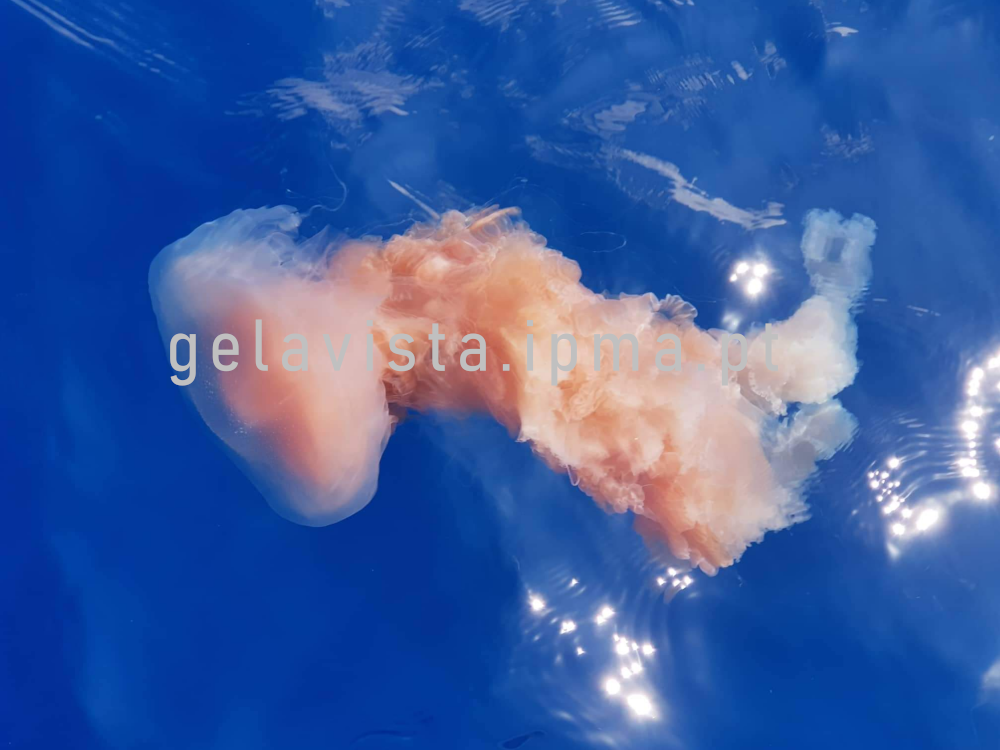
Well known as Portuguese Man o’ War, P. physalis is a Siphonophore and, in fact a colony of individuals specialized in different functions that together form a single organism. It floats across the sea surface propelled by winds and currents. Its tentacles can reach up to 30m in length. This species occurs frequently along the Portuguese coast, including Azores and Madeira and has the harshest sting of the jellyfish occurring in the area. Direct contact should always be avoided.
In case of stinging, clean it carefully, apply vinegar and hot packs over the affected region.

Distinguishable by its sail-like superficial structure, Velella floats and is influenced by winds and currents. These organisms sometimes form dense aggregates which can cover the water surface and beach areas when stranded. Their tentacles are short and slightly stinging. It is a common species in Portuguese waters occurring in late winter and spring months. Avoiding direct contact is recommended.

It is the most commonly occurring jellyfish across the coasts of mainland Portugal. It is easily sighted near ports and marinas, particularly near the Tagus and Sado Rivers. It is a sizeable species, and its sting is considered mild. It presents 8 oral arms and characteristic X-shaped gonads. The colour is variable, but mainly brown/white, with brown umbellar grooves.

It is considered the most common jellyfish in the Mediterranean Sea and the Azores but is rarely sighted in mainland Portugal. This species occurs more frequently during Spring and Summer. Its tentacles can reach up to 2m in length, and the stinging cells are concentrated in the tentacles and near the bell. The species is bioluminescent.
Avoid contact. In case of direct skin contact, clean it carefully, apply ice packs and sodium bicarbonate (if available).

This is a relatively common species, occurring with relative frequency along the Portuguese coast, the Gibraltar Strait and along the western African coast. It is a large-sized jellyfish, with a bell that can reach 60cm in diameter. It is easily recognisable by its long tentacles with dark extremities.

This species occasionally occurs across Portuguese coastal areas. Its sting is very painful. It can be easily identified by the brown bands in its bell.
In case of direct skin contact, clean it carefully, apply ice packs and sodium bicarbonate (if available).

Known as Moon Jelly, it is widespread, thriving in warm waters throughout all the oceans. It is frequently spotted near ports, marinas, coastal lagoons and estuaries. Its most distinguishable feature are the horseshoe-shaped gonads located in the centre of its bell.
In case of direct skin contact, apply ice packs and sodium bicarbonate (if available).

This species occurs in the Azores and Madeira waters during spring and summer. It is a large jellyfish known as fried egg jellyfish due to the yellow coloration in the center of its body that resembles an egg yolk. The body can have up to 60 cm in diameter and the tentacles are presented in 16 groups, each group containing 5 to 24. Oral arms are delicate curtain-shaped, with many folds.

These organisms are Tunicates and have a complex life cycle, both as solitary creatures, and as part of a colony. They feed primarily on phytoplankton and are common occurrences in productive areas. When aggregated in a colony, they link together to form chains several metres long. They are non-stinging.

These organisms are Tunicates that form a rigid tubular hollow structure, with one of its extremities open. They are non-stinging. They inhabit shallow and warm waters of the open ocean but can be found at high depths.

Known as sea gooseberry, it is a Ctenophora, known as comb jellies. It is a small, globular or ovoid and transparent jelly with a pair of long tentacles that are used to catch the preys. The body bears four pairs of longitudinal rows of cilia mounted on short transverse plates which are bioluminescent. They are non-stinging.

Near-transparent, oval-shaped organisms which display vertical bioluminescent bands made up of cilia. These organisms are comb jellies. They have tentacles, which are used for feeding. Its sightings in Portugal are rare and mainly in rivers estuaries. They are non-stinging.